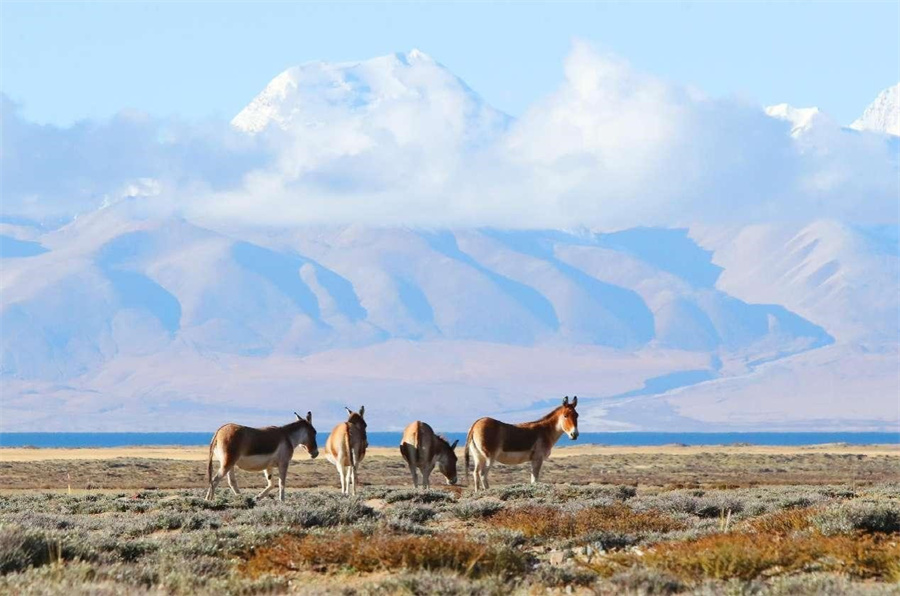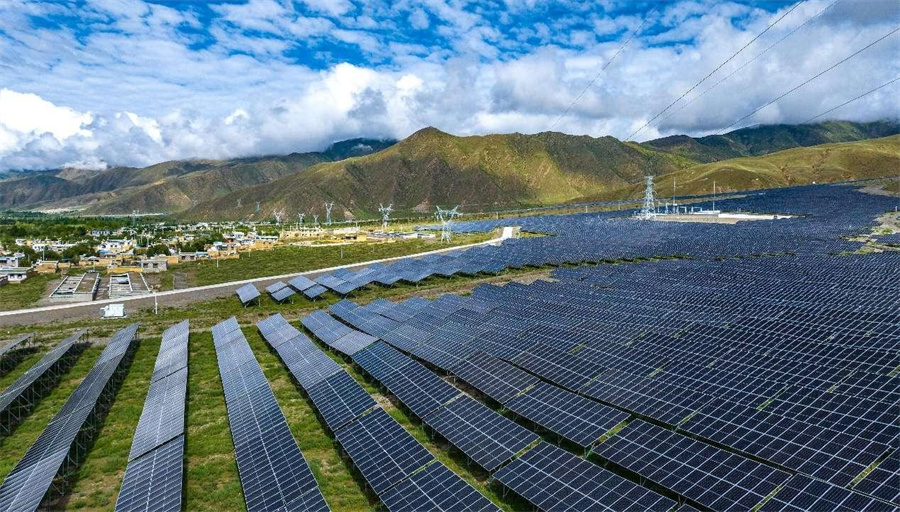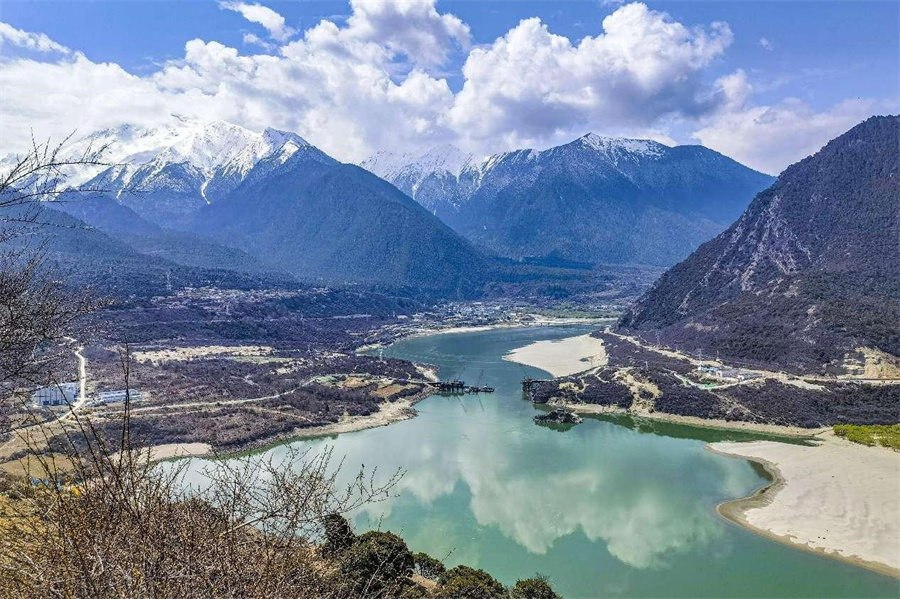Xizang keeps enhancing efforts in ecological conservation, restoration
To the southwest of Geladaindong Peak in northwest China's Qinghai province, stands Jianggudiru Glacier, which rises up to 6,542 meters above the sea level. It is one of the sources of the Yangtze River, the longest river in China.
At the foot of the glacier, lies Maqu township, Amdo county, Xizang autonomous region. To protect the glacier and the meadows surrounding it, Maqu township has reduced the number of livestock by nearly 40 percent in the recent decade.

Kiangs forage along a national highway in Burang county, southwest China's Xizang autonomous region, Oct. 12, 2024. [People's Daily Online/Wang Jianzhong]
"To chase short-term interests is something we'll never do," said Tsewang Drolma, Party head of Maqu township. According to her, the township has banned development in all forms within the key protection area of the glacier.
Protecting the ecological environment of Xizang benefits future generations and serves the whole world. In recent years, Xizang has kept enhancing ecological protection and restoration efforts to reinforce the shields for ecological security.
It has comprehensively implemented a law on ecological protection of the Qinghai-Xizang Plateau, and carried out large-scale land greening initiatives and urban space greening projects. It is also actively advancing the establishment of a protected areas framework with a focus on national parks.
Committed to optimizing the development of territorial space, Xizang is working to protect every blade of grass and every mountain and river on the plateau.
With the priority given to eco-environmental conservation, Xizang adheres to integrated conservation and restoration of mountains, rivers, forests, farmlands, lakes, grasslands, deserts, and glaciers.
The autonomous region has implemented regulations on building itself into a pacesetter of ecological civilization, enforced protective measures to restrict access to important snow-capped mountains and glaciers, and promoted the inclusion of key areas such as Changtang, Mount Qomolangma, and Mount Kailash into a layout plan of national parks. Currently, nature reserves in Xizang account for 36 percent of the autonomous region's total land area.

Photo shows a solar farm in Qonggyai county, Shannan city, southwest China's Xizang autonomous region. [People's Daily Online/Yang Dong]
As of the end of 2023, Xizang was home to 1,072 species of wild terrestrial vertebrates. It ranked among the top nationally in the number of large and medium-sized wildlife. In particular, the population of Tibetan antelope exceeded 300,000 in the autonomous region, while the number of Tibetan red deer, once believed to be extinct, had grown to over 800.
To improve the systematic governance mechanism, efforts have been strengthened for the ecological protection and restoration of important river basins.
In the middle reaches of the Yarlung Tsangpo River, a lush "green ecological corridor" that is around 1,800 meters wide stretches approximately 160 kilometers long.
From a high vantage point in Luodui village, Chaqi township, Chanang county, one can see endless trees.
"Forty years ago, there wasn't a single tree here. Now, greenery is increasing," said villager Paljor, who manages a nursery spanning over 450 mu, or 30 hectares.
In recent years, he has taken on a number of greening projects. "We've improved the environment, earned money, and lifted our living standards - all in one go," he said.
Xizang is accelerating key ecological projects, including afforestation in the mountains to the north and south of Lhasa and around Gonggar Airport in the middle reaches of the Yarlung Tsangpo River, and greening projects for the basins of the Yarlung Tsangpo, Nujiang, Lhasa, Nyangqu, Yalong and Shiquan rivers.
The region is also establishing an ecological compensation mechanism that covers forests, wetlands, grasslands, and water ecosystems.

Photo shows a magnificent view of the Yarlung Tsangpo River in southwest China's Xizang autonomous region. [People's Daily Online/Sun Zhifang]
In 2023, Xizang completed 1.2 million mu of afforestation, restored and rehabilitated 6.14 million mu of degraded grasslands. Its forest coverage rate was lifted to 12.31 percent, and fractional vegetation coverage on grasslands to 48.02 percent.
Nyingchi has been recognized as a national forest city, while 11 counties, county-level cities and districts, including Bome, Qonggyai and Jomda, have been awarded the title of national demonstration zones for eco-environmental progress.
In the 2023 report on Xizang's ecological environment, all ecological quality indicators were rated as excellent. The health rating for rivers and lakes across the autonomous region stood at 100 percent, and 99.96 percent of key rivers and lakes met standards regarding ecological flow. The report said Xizang is one of the regions with the best ecological quality in the world.
With continuous improvement in ecological quality, a green development pattern has been initially established in Xizang. The clean energy and low-carbon industries are growing steadily, with clean energy accounting for over 90 percent of the installed power capacity in the autonomous region. More than 2.2 million farmers and herders benefit from subsidies for grassland ecological protection.
Wang Junzheng, secretary of the Communist Party of China Xizang Autonomous Regional Committee, said that Xizang will continuously enhance its sense of responsibility and mission in ecological and environmental protection.
The region will make every effort to safeguard the ecology of the Qinghai-Xizang Plateau according to law, and strive to build a beautiful Xizang where human and nature coexist harmoniously, Wang added.
























